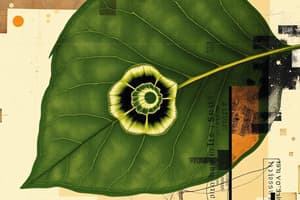Podcast
Questions and Answers
What is the primary function of the leaf in plants?
What is the primary function of the leaf in plants?
Which adaptation helps leaves capture sunlight effectively?
Which adaptation helps leaves capture sunlight effectively?
How do palisade mesophyll cells maximize light absorption?
How do palisade mesophyll cells maximize light absorption?
What is the primary role of the chloroplast envelope?
What is the primary role of the chloroplast envelope?
Signup and view all the answers
What is the stroma within a chloroplast?
What is the stroma within a chloroplast?
Signup and view all the answers
Which structure in the leaf is responsible for gas exchange?
Which structure in the leaf is responsible for gas exchange?
Signup and view all the answers
Why are chloroplasts typically disc-shaped?
Why are chloroplasts typically disc-shaped?
Signup and view all the answers
What is the primary purpose of photophosphorylation in the light-dependent stage of photosynthesis?
What is the primary purpose of photophosphorylation in the light-dependent stage of photosynthesis?
Signup and view all the answers
Which photosystem is associated with a light absorption peak of 700 nm?
Which photosystem is associated with a light absorption peak of 700 nm?
Signup and view all the answers
In cyclic photophosphorylation, what happens to the electrons after they are excited?
In cyclic photophosphorylation, what happens to the electrons after they are excited?
Signup and view all the answers
Which process occurs when light splits water molecules during photosynthesis?
Which process occurs when light splits water molecules during photosynthesis?
Signup and view all the answers
Where does non-cyclic photophosphorylation primarily take place?
Where does non-cyclic photophosphorylation primarily take place?
Signup and view all the answers
What is the primary function of thylakoids in chloroplasts?
What is the primary function of thylakoids in chloroplasts?
Signup and view all the answers
Which pigment is primarily responsible for the absorption of light energy in photosynthesis?
Which pigment is primarily responsible for the absorption of light energy in photosynthesis?
Signup and view all the answers
What characterizes accessory pigments like carotene and xanthophyll?
What characterizes accessory pigments like carotene and xanthophyll?
Signup and view all the answers
What structure connects thylakoids of adjacent grana?
What structure connects thylakoids of adjacent grana?
Signup and view all the answers
During chromatography, what is used to separate photosynthetic pigments?
During chromatography, what is used to separate photosynthetic pigments?
Signup and view all the answers
Which of the following elements is NOT mentioned as being contained in chlorophyll?
Which of the following elements is NOT mentioned as being contained in chlorophyll?
Signup and view all the answers
What is the role of the protein matrix in photosystems?
What is the role of the protein matrix in photosystems?
Signup and view all the answers
When comparing photosystem I and II, which of the following statements is true?
When comparing photosystem I and II, which of the following statements is true?
Signup and view all the answers
The effectiveness of different wavelengths of light for photosynthesis is summarized in which type of spectrum?
The effectiveness of different wavelengths of light for photosynthesis is summarized in which type of spectrum?
Signup and view all the answers
What is the function of ATP synthase complexes found in granal membranes?
What is the function of ATP synthase complexes found in granal membranes?
Signup and view all the answers
Study Notes
Structure and Function of Leaves
- Leaves are the primary photosynthetic organs in plants, facilitating the process of photosynthesis largely within palisade and spongy mesophyll tissues.
- Chloroplasts, the organelles involved in photosynthesis, are concentrated in these mesophyll cells.
- Key adaptations of leaves include:
- Large surface area to maximize sunlight capture.
- Thin lamina for short diffusion distances.
- Transparent cuticle and epidermis allowing light penetration.
- Numerous stomata enabling gas exchange, responsive to light intensity.
- Air spaces in spongy mesophyll for efficient gas diffusion.
- Vascular tissue network: xylem for water transport and phloem for sugar distribution.
Palisade Mesophyll Adaptations
- Palisade mesophyll cells are optimized for photosynthesis:
- Closely packed and thin-walled to capture light efficiently.
- Vertically arranged to minimize obstructions to light.
- High chloroplast density, with chloroplasts positioned for optimal light absorption.
- Large vacuoles push cytoplasm to the edges, reducing diffusion distance for carbon dioxide.
- Moist, thin walls facilitate rapid gas diffusion.
Chloroplast Structure and Function
- Chloroplasts are disc-shaped organelles, typically 3-10 µm long with a double membrane (chloroplast envelope).
- Internal compartments include:
- Stroma: Fluid matrix for light-independent reactions, contains starch grains, lipids, circular DNA, and ribosomes.
- Grana: Stack of thylakoids where light-dependent reactions occur, containing chlorophyll pigments and proteins for light absorption.
- Thylakoids connected by inter-granal lamellae, hosting photosystems I and II.
Photosystems and Pigments
- Photosystems consist of chlorophyll a, accessory pigments (carotene and xanthophyll), and associated proteins, crucial for capturing light.
- Photosystem I (PSI): Absorbs light at 700 nm (P700), mostly located on inter-granal lamellae.
- Photosystem II (PSII): Absorbs light at 680 nm (P680), primarily found in granal lamellae.
Light Absorption and Action Spectra
- Chlorophyll pigments absorb light in blue and red wavelengths, with chlorophyll a being the primary photosynthetic pigment.
- Action spectra illustrate wavelength effectiveness in photosynthesis, peaking at blue (450 nm) and red (650 nm).
Light Harvesting and Energy Transfer
- Groups of chlorophyll and accessory pigments form photosystems to absorb light collectively, necessary for oxygen production.
- Absorbed light energy excites electrons in the reaction center of chlorophyll, initiating their transfer through a series of electron carriers.
Light-Dependent Reactions
- Capture light energy in thylakoids to produce ATP and NADPH via:
- Photophosphorylation: Adding phosphate to ADP to form ATP using light energy.
- Photolysis: Splitting water into oxygen, protons, and electrons.
Electron Transport
- Excited electrons can enter two processes:
- Cyclic Photophosphorylation: Involves only PSI; electrons are recycled to generate ATP without producing NADPH.
- Non-Cyclic Photophosphorylation: Combines PSI and PSII; provides electrons to NADP+, forming reduced NADP+ for use in the light-independent stage.
Additional Notes on Pigments and Chromatography
- Various pigments can be separated using chromatography based on solubility and molecular mass.
- Rf values help identify individual pigments during chromatography experiments, crucial for understanding photosynthetic processes.
Studying That Suits You
Use AI to generate personalized quizzes and flashcards to suit your learning preferences.
Description
Explore the structure and adaptations of leaves, the primary photosynthetic organs in plants. This quiz covers important features like mesophyll tissues, chloroplasts, and various adaptations that enable efficient photosynthesis and gas exchange.




